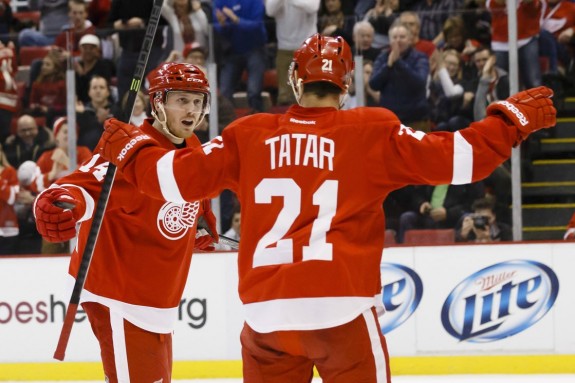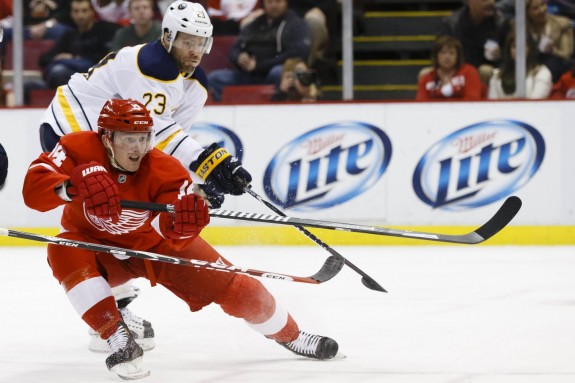The 2013-2014 Detroit Red Wings were not a team that you would discuss with your children or grandchildren. They were a mediocre offensive team, a sloppy defensive team, and were saddled with injuries throughout the entire season. They barely qualified for the playoffs and then were thoroughly outplayed by the Boston Bruins in the playoffs and exited quietly after five games. However, throughout the season there were so many great highlights and stories. There was the fantastic play by backup goaltender Jonas Gustavsson. There was the continued improvement of defenseman Brendan Smith. There was the emergence of “The Kid Line”, consisting of Tomas Tatar, Riley Sheahan, and Tomas Jurco. Most importantly though, there was Gustav Nyquist. [By the way – if you like this post, be sure to sign up for our weekly newsletter. We send 1 or 2 of our best articles out per week.]

Nyquist started the season in Grand Rapids due to the fact that he was the only player that could be sent down to the minors without having to clear waivers. Once the injury parade started, he was called up and never looked back. In fact, Nyquist went on one of the greatest scoring streaks for a player his age in recent history, scoring a magnificent 23 goals in 28 games. Nyquist singlehandedly carried the Wings into the playoffs as captain Henrik Zetterberg and all-universe Pavel Datsyuk sat on the sidelines with injuries. However, we knew Nyquist wouldn’t be able to keep up that pace. He was scoring on an ungodly 19.4% of his shots at one point in time which is a highly unsustainable percentage. Most of us did not expect Nyquist to go as cold as he did.
After scoring that incredible goal against the Bruins on April 2nd, Nyquist finished the regular season and playoffs on an 11-game goal drought, registering just two assists in those 11 games. The 11 games was Nyquist’s longest stretch this season without a goal. That being said, what should we expect from Nyquist next season? Will he be the flying dynamo that he was when he scored 23 goals in 28 games, or should we expect the drop-off in play that we saw at the end of the season to continue?
Nyquist’s Streaks
A quick examination of those 11 games shows some very interesting numbers . I’ll first start off by saying that five of the 11 games we are looking at were against Boston and eight of the 11 were against playoff teams. This is definitely a higher quality of competition in the sample size than a player would normally face over the course of the season. Below is a table comparing Nyquist’s numbers during his 28-game hot streak and his 11-game cold streak. All data is taken from Extra Skater.
| Player | Minutes/Game | Shots/Game | 5-on-5 CF% | Shooting % |
|---|---|---|---|---|
| Nyquist 11-game cold streak | 16.5 | 2.5 | 62.3% | 0.00% |
| Nyquist 28 game hot streak | 17.3 | 3.0 | 55.2% | 27.1% |
The first thing to note is Nyquist’s ridiculous shooting percentage. Nyquist scored 23 goals on 85 shots. That’s not supposed to happen in the NHL and it was clear that he was going to regress. The more important thing to notice is that Nyquist was actually better in terms of 5-on-5 Corsi for%. A simple explanation of that stat is that when he was on the ice in 5-on-5 situations, the Wings were directing 62.3% of all shot attempts at the opposition’s goal. Again, the 62.3% is most likely not a sustainable figure as the best 5-on-5 Corsi forwards this season were Boston’s Patrice Bergeron (61.2%), and Los Angeles’ Anze Kopitar (61.0%), and Justin Williams (60.6%).
The last thing to take away from the table is that Nyquist generated fewer shots per game. While you might think that generation half a shot less per game really isn’t that significant of a difference, it actually is. If you play out 2.5 shots per game over 82 games, you get 205 shots on goal. That would have ranked Nyquist 56th among forwards for the season. However, an average of three shots on goal per game leads to a total of 246 shots on goal for a season which would have ranked 20th among forwards. The 246 shots on goal is better than forwards such as Zach Parise, Bergeron, Marian Hossa, and James Neal.

Nyquist’s Projection For Next Year
What does all of this mean? Well to be honest, after looking at all of the numbers, it seems as if Nyquist got really lucky by scoring on 27.1% of his shots during his hot streak, and then really unlucky during his 11-game cold streak. I think if we average the two streaks, we might get a better approximation of what Nyquist might give the Wings next year. Below is a table showing Nyquist’s last 39 games through both streaks, and what an 82-game projection would look like using those numbers.
| Player | Minutes/Game | Shots | Goals | Assists | Points | 5-on-5 CF% | Shooting % |
|---|---|---|---|---|---|---|---|
| Gustav Nyquist last 39 games | 17.1 | 112 | 23 | 14 | 37 | 57.1% | 20.5% |
| Nyquist 82-game projection | 17.1 | 235 | 48 | 30 | 78 | 57.1% | 20.5% |
A quick look at this table reveals the obvious – Nyquist is not going to shoot 20.5% for an 82-game season. This past season, the highest shooting percentage of any player taking more than 200 shots was 18.2% from San Jose’s Joe Pavelski. The average shooting percentage of the players who took more than 200 shots this season is 11.5%. If we take that shooting percentage and apply it to Nyquist’s projected 235 shots on goal, that gives us 27 goals over 82 games, a far more reasonable projection. Of course, none of these projections factor in Nyquist’s growth as a player. Last year in the 2013 playoffs, we saw flashes of brilliance from Nyquist in the series against the Anaheim Ducks. He took a massive leap forward this year and who knows how big of a jump he’ll actually take.
I’ll attempt to quantify the jump Nyquist takes by comparing the season he just had to a player that came on similarly to Nyquist. Prior to this season, Nyquist had played in 40 games and was 23 years of age. He had a total of four goals and 13 assists to his name and not a much else. The player I think Nyquist best compares to, at least at this point in his career, is Zigmund Palffy. Look at the statistical similarities from their first two seasons. The offensive point shares and goals created stat come from Hockey Reference.
| Player | Height | Weight | Games Played | Goals | Assists | Points | Shots | Offensive Point Shares |
|---|---|---|---|---|---|---|---|---|
| Gustav Nyquist | 5’10” | 185 | 40 | 4 | 9 | 13 | 65 | 0.5 |
| Zigmund Palffy | 5’10” | 183 | 38 | 10 | 7 | 17 | 80 | 1.1 |
Now look at a comparison between their third seasons in the NHL.
| Player | Age | Games Played | Goals/Game | Assists/Game | Points/Game | Shots/Game | Shooting % | Goals Created/Game |
|---|---|---|---|---|---|---|---|---|
| Gustav Nyquist | 24 | 57 | 0.49 | 0.35 | 0.84 | 2.68 | 18.3% | 0.36 |
| Zigmund Palffy | 23 | 81 | 0.53 | 0.54 | 1.07 | 3.17 | 16.7% | 0.44 |
You can see that their third seasons were very similar. Had Nyquist been able to start the season with Detroit, the comparison might be even closer. We can see that Palffy was slightly better offensively, but for those that actually watched both Palffy and Nyquist, it’s clear that Nyquist is the superior defensive player at this point of their careers. The good news for Wings’ fans is that in Palffy’s fourth season, his numbers jumped even higher, to 48 goals and 90 points in 80 games. Palffy went on to finish his career with a 329 goals and 713 points in 684 games.
I think if I were to offer a projection for Nyquist it would have a best case and worst case scenario. In the worst case scenario, Nyquist scores 20 goals, 25 assists, and struggles to maintain consistency. He has stretches where he is on fire, and then he disappears. He essentially becomes the next Johan Franzen (sorry Mule, but it’s true). The best case scenario sees Nyquist start the season on fire and he never lets his foot off the gas. He tears up the league, scoring 45 goals, 95 points, and is a Hart Trophy candidate. Finally, the most realistic scenario I can provide is Nyquist plays similar to this year, with just a touch more consistency, and he scores 33 goals, 70 points, and finally provides the Wings with the consistent third scoring option they’ve missed since Marian Hossa left in 2009. If Nyquist can keep up this continued growth, 20 years from now we might actually look back at the 2013-2014 team and tell our children/grandchildren, “there was this team, and then there was this player…”.
Good stuff man. I don’t predict much out of him…. you can’t just expect ton from a 2nd/3rd liner.
What I project from Nyquist:
Games Played: 74 (maybe 82, if Babcock is willing to play him A LOT)
Goals: 23 (IMO, if he keeps up his faith in himself, and the Wing Fans cheer him on…. he will achieve 30+ goals)
Assists: 25 (If he does like what I sad above… he will get 30-45 assists)
Points: 48 (Like above… maybe around 50-75 points)
Plus/Minus: +14 (Depends…. if the Wings can actually do well defensively.)
Penalties: 6-9 (probably…. would seem kind of realistic. But he seems like a ‘clean’ player. As I seen him play)
Shots: AT LEAST 225. (A lot more probably)
But to be looking at his stats so far in the NHL, looks to be a decent player and might just stay put in the NHL. He is GREAT in the AHL, so if the Wings decide (I don’t get why they would) to send him down to the AHL…. Everyone will be able to punch the Wings GM and Coaching Staff.
I can see him playing on the Wings years to come. He isn’t a money HOG, neither a big penalty taker. So, it’s tough to say. He is probably one of the most quality and ‘big’ young player in the NHL. He is a threat to every team… (Boston knows that…. since he can get past big ol’ Chara).
Lets just hope Nyquist will revolutionize the Joe and the Fans. Make the Goal Horn go off often and have the the commenters say: “He shoots… and he scores!!!! Gustav Nyquist!!!!!!”
Great insight. Almost exhausting to read all those numbers, phew! I plan on seeing a more consistent offense next year that will give Nyquist more assists.
I project ~25 goals, ~35 assists.